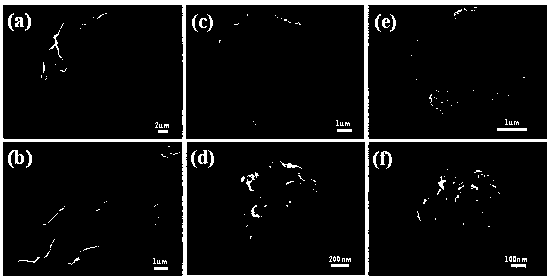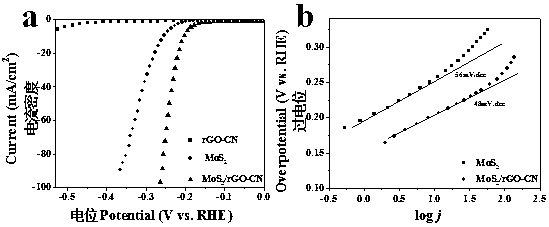Preparation method and application of MoS2/rGO-CN composite material
A composite material, rgo-cn technology, applied in the field of electrocatalytic hydrogen evolution, can solve the problems of poor conductivity and easy accumulation of molybdenum disulfide
- Summary
- Abstract
- Description
- Claims
- Application Information
AI Technical Summary
Problems solved by technology
Method used
Image
Examples
Embodiment 1
[0029] Weigh 45 mg of graphite oxide and place it in a beaker, add 15 mL of deionized water, ultrasonically disperse and then add 27 mg of melamine to ultrasonically dissolve again to form a colloidal solution. The above colloidal solution was transferred to a 25 mL polytetrafluoroethylene-lined reactor, and then the reactor was placed in an oven at 120 °C for 6 h, cooled to room temperature, and finally freeze-dried to obtain a black substance. Then transfer the obtained black substance into a porcelain boat, and then transfer it to a temperature-programmed tube furnace. Under the protection of argon, the temperature-programmed tube furnace is heated to 600 °C at a heating rate of 2.3 °C / min and then kept for 2 hours. After being naturally cooled to room temperature, it was taken out to obtain reduced graphene oxide-nitrogen carbide (rGO-CN).
[0030] Weigh 1 mg ammonium tetrathiomolybdate ((NH 4 ) 2 MoS 4 ) and 2 mg rGO-CN were placed in a beaker, then 15 mL DMF was added...
Embodiment 2
[0032] Weigh 45 mg of graphite oxide and place it in a beaker, add 15 mL of deionized water, ultrasonically disperse and then add 27 mg of melamine to ultrasonically dissolve again to form a colloidal solution. The above colloidal solution was transferred to a 25 mL polytetrafluoroethylene-lined reactor, and then the reactor was placed in an oven at 120 °C for 6 h, cooled to room temperature, and finally freeze-dried to obtain a black substance. Then transfer the obtained black substance into a porcelain boat, and then transfer it to a temperature-programmed tube furnace. Under the protection of argon, the temperature-programmed tube furnace is heated to 600 °C at a heating rate of 2.3 °C / min and then kept for 2 hours. After being naturally cooled to room temperature, it was taken out to obtain reduced graphene oxide-nitrogen carbide (rGO-CN).
[0033] Weigh 3 mg ammonium tetrathiomolybdate ((NH 4 ) 2 MoS 4 ) and 2 mg rGO-CN were placed in a beaker, then 15 mL DMF was added...
Embodiment 3
[0035] Weigh 45 mg of graphite oxide and place it in a beaker, add 15 mL of deionized water, ultrasonically disperse and then add 27 mg of melamine to ultrasonically dissolve again to form a colloidal solution. The above colloidal solution was transferred to a 25 mL polytetrafluoroethylene-lined reactor, and then the reactor was placed in an oven at 120 °C for 6 h, cooled to room temperature, and finally freeze-dried to obtain a black substance. Then transfer the obtained black substance into a porcelain boat, and then transfer it to a temperature-programmed tube furnace. Under the protection of argon, the temperature-programmed tube furnace is heated to 600 °C at a heating rate of 2.3 °C / min and then kept for 2 hours. After being naturally cooled to room temperature, it was taken out to obtain reduced graphene oxide-nitrogen carbide (rGO-CN).
[0036] Weigh 7 mg ammonium tetrathiomolybdate ((NH 4 ) 2 MoS 4 ) and 2 mg rGO-CN were placed in a beaker, then 15 mL DMF was added...
PUM
 Login to View More
Login to View More Abstract
Description
Claims
Application Information
 Login to View More
Login to View More - R&D
- Intellectual Property
- Life Sciences
- Materials
- Tech Scout
- Unparalleled Data Quality
- Higher Quality Content
- 60% Fewer Hallucinations
Browse by: Latest US Patents, China's latest patents, Technical Efficacy Thesaurus, Application Domain, Technology Topic, Popular Technical Reports.
© 2025 PatSnap. All rights reserved.Legal|Privacy policy|Modern Slavery Act Transparency Statement|Sitemap|About US| Contact US: help@patsnap.com



